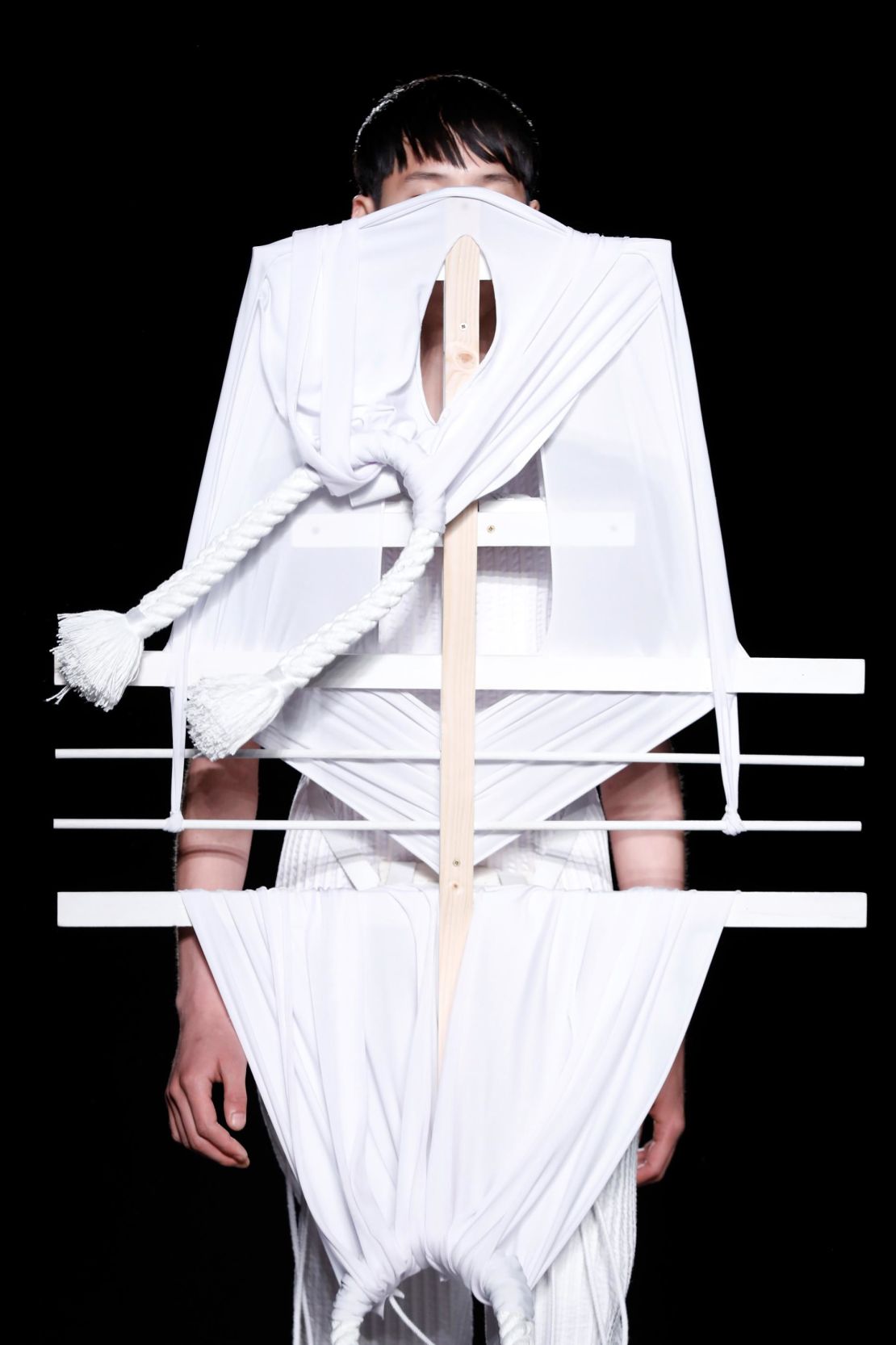There is very little that resembles actual clothing in Craig Green’s latest ad campaign. Instead, the images capture various pieces of jersey fabric from his Spring-Summer 2018 collection stretched over elaborate, layered wooden structures. In other photos, the structures and fabric are being burned to the ground.
If that description reads like a metaphor for troubling times, Green stresses that he isn’t interested in using his brand to comment on Trump’s America, Brexit or any of the other political topics that so often jump from news headlines.
“I think it’s impossible for anyone to not be influenced about what is going on in the world at any time,” he said in a phone interview. “But (for me), it’s never a starting point, or a comment or political approach.”
Green – a soft-spoken London native who has been a darling of the city’s menswear scene since he launched his namesake label in 2012 – is much more interested in exploring menswear from a practical point of view.
“The whole idea of the brand from the beginning has been based around ideas of uniform and communal ways of dress,” he explains. “I think it’s beautiful, that idea of a grouping of people and a uniform that makes everyone an equal.”
Craig Green Spring-Summer 2018 campaign
That mission statement makes his designs, which are often intricate and architectural, all the more intriguing for those within the fashion industry who have showered him with accolades and made his runway shows one of the hottest tickets of London Fashion Week. But how does someone who sets out to explore functional, egalitarian clothing end up with a suit made from what resembles long, bulky strips of church carpeting, for example, as Green did in his Autumn-Winter 2017 collection? Or land upon the body-swallowing, multi-colored poncho, like the one recently worn on stage by Jared Leto? And what is the average consumer to make of it all?
In an ideal world, Green would prefer not to explain his process at all: “Sometimes I think it’s better to say nothing about things,” he said. “I think it’s nicer when people interpret them in their own way.”

That approach has resonated with insiders. Green’s serene, monochromatic debut collection brought his audience of fashion editors and buyers to tears in 2014, though he offered little about what inspired his designs.
Green’s clothes were promptly picked up by avant-garde boutiques like Dover Street Market. Awards also began rolling in, solidifying his place at the forefront of London’s next generation of design talent.
At the 2014 British Fashion Awards, Green won the prize for Emerging Menswear Designer. Later, he would go on to win the trophy for British Menswear Designer at the Fashion Awards in 2016 and 2017, and the £150,000 ($210,000) British Fashion Council/GQ Designer Menswear Fund in 2016. Fashion critic Tim Blanks compared him to industry legends Vivienne Westwood and Rei Kawakubo of Comme des Garçons. “The Cult of Craig is about to explode,” Blanks wrote in one early review.

And he was right: dedicated fashion fans enthusiastically snatched up Green’s designs.
As he looked to grow his business, Green knew that the inventiveness and artistry that won him his cult following could prove to be a barrier of entry to mainstream success – the kind that maintains a brand once the emerging designer prize money has been spent. While each runway show does contain simple, practical pieces, it requires close attention to find them amid the showstoppers.
“I think people, when they see the catwalk shows, those are extreme visuals … they might initially find it hard to relate to them in terms of what they could wear and how they can see themselves in it,” he said.

To that end, Green found a way to address both sides of his business. Last year, he launched what he calls his core collection.
“The core started from the idea of pieces from the runway collection that were either bestsellers or things that we love to wear in the studio every day,” he explained. “It’s very functional. Whereas the main line felt like a broad kind of research and the clothing comes together toward the end of the process, the core starts off with function from the very beginning.”
Shoppers can now find straight leg denim, a hoodie with subtle chord lacing around the side seam, or a lightweight jacket with vertical quilted strips, which has become a signature style for Green. The details relate to the main collection, but don’t look out of place on a city sidewalk.

“It’s quite casual. Every garment is based from our signature workwear jacket and every pattern is taken from that block,” Green says. “The idea is that you can have the same vision board, so you can wear a piece of it and live your life and not feel too flashy. We’re not all meant to be flashy all the time.”
That new ad campaign, in some ways, can be interpreted as a symbol of Green’s creative process as he finds a way to show a wider audience why fashion insiders have been celebrating him for years.
“I do like the idea of making something that takes so long,” Green said of the structures in the campaign images. “Being so precious and painstakingly precise about it, and then destroying it. The destroying part of it is almost as beautiful as the object that we tried to make.”
“It’s that idea of ripping things up and starting again, which is what you always do in fashion,” he continued. “Ripping up ideas and smashing out new and stranger things – probably better ideas in the end, anyway.”






